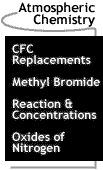

 |
Atmospheric Chemistry Ozone is a form of oxygen which has both harmful and beneficial qualities. While each molecule of the normal oxygen we breathe is composed of two oxygen atoms, each ozone molecule has three. At ground level, ozone is considered a pollutant, formed in urban areas by reactions of volatile organic compounds (hydrocarbons) and oxides of nitrogen (NOx). It is highly reactive and harmful to humans, animals, and plants. Because of its high reactivity and ability to harm microscopic organisms, ozone is used in some parts of the world to purify water. Ozone protects the lower atmosphere and Earth's surface by absorbing ultraviolet radiation in the stratosphere. Understandably, we are concerned with the decreases in stratospheric ozone concentrations. Antarctic Ozone Concentrations Ozone is a very rare gas with very small concentrations. In fact, if all the ozone present in the stratosphere were brought to Earth's surface at standard temperature and pressure (°C and 1 atm), it would comprise a layer less than 3 mm thick. Both human causes and natural events can influence the balance between the production and destruction of ozone. Since uv radiation is responsible for the production of ozone, there is a cycle of ozone amounts related to solar output. Manmade chemicals capable of reacting with ozone and volcanic eruptions work to upset the balance in ozone production and destruction. Manmade chemicals that have been implicated in ozone depletion include chlorofluorocarbons (CFCs). These compounds tend to be very stable near Earth's surface and mix uniformly into the high atmosphere, but in the stratosphere, they are unstable. One CFC, CFC4, has been found to be uniformly mixed from 10 to 50 km, with mixing ratios that varied only over the small range of 0.056 to 0.060 ppbv. Strictly speaking, definition of a CFC is a compound containing carbon, fluorine, and chlorine atoms. Sometimes a broader definition is applied and hydrochlorofluorocarbons, such as CHClF2 are included (here, a hydrogen atom is found in place of a chlorine or fluorine would normally be found). Many different CFCs exist. The simplest contain one carbon atom in combination with a total of four chlorine and fluorine atoms. The process by which CFCs destroy ozone involves the action of uv radiation on a CFC molecule. These molecules are highly unreactive near Earth. For this reason, they were considered to be very safe. High in the stratosphere, however, they are essentially destroyed by uv radiation which releases a chlorine atom.
Let's see what happens to CFCl3, a refrigerant, with the designations, CFC-11 and R-11: CFCl3 + hu --> CFCl2 + Cl. (hu represents a packet of electromagnetic energy, h is a fixed number called Planck's constant, while u represents frequency of the radiation.) The released chlorine atom is now free to react with an ozone molecule: Cl + O3 --> ClO + O2, destroying the ozone molecule. The chlorine monoxide (ClO) that has just formed then reacts with monatomic oxygen: ClO + O --> O2 + Cl. The chlorine atom is now free again and is capable of destroying another ozone molecule. This very efficient process can repeat up to 100,000 times. So, in effect, one chlorine atom has the capability of destroying up to 100,000 ozone molecules.
Halons used to extinguish fire are placed in another class of ozone-destroying chemicals. Because they contain bromine, they are three to ten times more dangerous than CFCs in ozone destruction potential. Halons include CF2BrCl, CF3Br, and C2F4Br2. Hydrochlorofluorocarbons, such as CHFCl2 and CH2FCl, which have a hydrogen atom in place of one or two of the halogens are only about 10% as harmful as CFCs and were considered as interim substitutes. However, one reason they are less harmful is that they are more unstable than CFCs and often enter into reactions in the troposphere. This can shorten their lifetimes and the lifetimes of the equipment and fluids with which they interact. Hydrofluorocarbons are ozone-friendly because fluorine forms stable compounds in the stratosphere. However, they have the potential to contribute to global warming. (CFC replacements) Many other substances involved in ozone depletion have both natural and manmade sources. Methyl chloride (CH3Cl) and methyl bromide (CH3Br) are examples of such compounds. The oceans and biomass burning are sources of these compounds. Methyl bromide is particularly destructive and is used as a pesticide, where it is injected into soil to kill pests. Unfortunately, 50% to 90% escapes into the atmosphere and is fifty times more effective in destroying ozone than is chlorine from CFCs. Oxides of nitrogen also have both natural and manmade sources. In the Arctic, these processes at work with solar illumination help reduce ozone concentrations from 550 to 380 Dobson units between the spring and fall equinoxes.
[ Atmospheric Physics ] [ Atmospheric Chemistry: CFC
Replacements / [ Home ] [ Teacher Pages ] [ Modules & Activities ] |
HTML code by Chris Kreger
Maintained by ETE Team
Last updated April 28, 2005
Some images © 2004 www.clipart.com
Privacy Statement and Copyright © 1997-2004 by Wheeling Jesuit University/NASA-supported Classroom of the Future. All rights reserved.
Center for Educational Technologies, Circuit Board/Apple graphic logo, and COTF Classroom of the Future logo are registered trademarks of Wheeling Jesuit University.